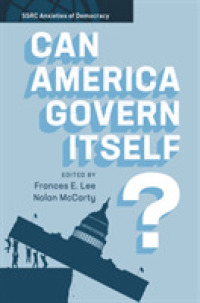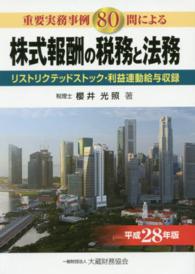Full Description
This book explores how the recruitment and retention of Asian international students in Canadian universities intersects with other institutional priorities. Responding to the growing need for new insights and perspectives on the institutional mechanisms adopted by Canadian universities to support Asian international students in their academic and social integration to university life, it crucially examines the challenges at the intersection of two institutional priorities: internationalization and anti-racism. This is especially important for the Asian international student group, who are known to experience invisible forms of discrimination and differential treatment in Canadian post-secondary education institutions. The authors present new conceptualisations and theoretical perspectives on topics including international students' experiences and understandings of race and racism, comparisons with domestic students and/or non-Asian students, institutional discourse and narratives on Asian international students, comparison with other university priorities, cross-national comparisons, best practices, and recent developments linked to the COVID-19 pandemic. Foregrounding the institutional strategies of Canadian universities, as opposed to student experience exclusively, this direct examination of institutional responses and initiatives draws out similarities and differences across the country, compares them within the broader array of university priorities, and ultimately offers the opportunity for Canadian universities to learn from each other in improving the integration of Asian international students and others to their student body. It will appeal to teacher-scholars, researchers and educators with interested in higher education, international education and race and ethnic studies.
The Open Access version of this book, available at http://www.taylorfrancis.com, has been made available under a Creative Commons Attribution-Non Commercial-No Derivatives (CC-BY-NC-ND) 4.0 license.
Contents
Introduction: International Students from Asia and Canadian Universities: Institutional History and Trends. SECTION 1: Institutional Contexts: A Critical View. 1. The Ruling Relations of the Internationalizing Canadian University. 2. International Students and Equity, Diversity, Inclusivity (EDI) in Canadian Universities: A Critical Look. 3. For Students, Look East; For Partners, Look West: How Canadian Internationalization Strategies Portray Asia and Europe. 4. Framing International Students from Asia in Ontario Universities: Provincial Priorities, Deficit-focused Services and Economic Benefits. 5. International Education Pipeline: An Analysis of British Columbia's University Transfer System. SECTION 2: Inclusion and Exclusion in Universities. 6. Assessments of universities by international students from Asia: Institutional resources, adjustment, inclusion and safety. 7. Between Intellectual Gateway and Intellectual Periphery: Chinese International Student Experiences. 8. Understanding Chinese Students' Manifold Transitions in a Canadian University. 9. Voices from Chinese International Students on Resources Offered by Montreal Universities: Pathways towards Equity and Social Justice. 10. Asian international students studying in Canada: A review of barriers to the learning experience by revisioning of Astin's I-E-O Model. 11. Pushed to the Periphery: Understanding the Multiple Forms of Exclusion Experienced by Asian International Students. SECTION 3: Anti-Asian Racism and the Politics of Race. 12. Asian International Students at the University of Toronto: How Diversity Discourses Downplay Student Demographics. 13. An East Coast Racial Reckoning: International Students and the Politics of Race at Dalhousie University. 14. Asian international Students in a mid-sized Canadian University: A Case study of the University of Manitoba. 15. Neo-racism, Neo-nationalism and the Recruitment of International Students to Canada in the Era of the Pandemic. 16. The impact of the COVID-19 pandemic on the racial experiences of international university students from Korea in Canada and the US. Conclusion: Building on Success from the Bottom-up? Institutional Challenges, Racialized Experiences, and Opportunities for Further Research.








